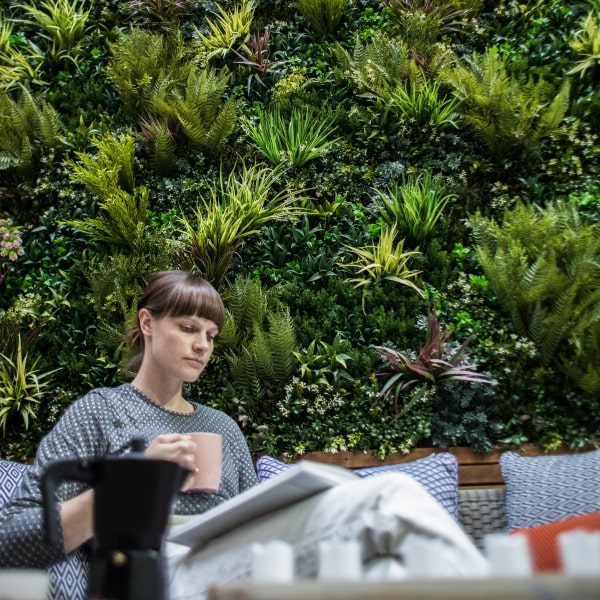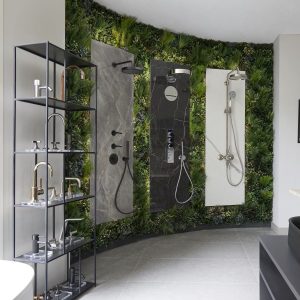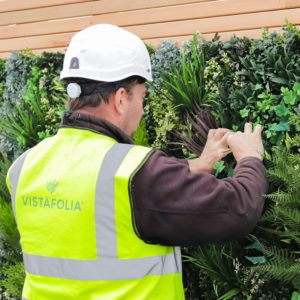Vertical gardens feel like a very twenty-first century invention. And the reason why you are increasingly likely to come across them in the media, down the high street and in your landscaper’s plans is that they’re a very good solution to twenty-first century problems. As cities, towns and suburbia become increasingly crowded and multiple homes and apartments are shoehorned into plots where previously, perhaps, there was only one residence, the possibility of incorporating anything more than the minimum of grass, trees and planting into such schemes becomes vanishingly small.
It is not unusual nowadays to find back gardens of new-builds that are dominated by six-foot-high boundary fencing that has been erected very close to the house; the front garden might have one small bed under the front window and the rest paved for parking. How often do you see apartments that don’t even have a balcony for pots, let alone more than the most rudimentary green space at the entrance?
Vertical Gardens – making us healthier
These issues have broader ramifications than the apparent lack of horticultural opportunities. It’s a problem that goes to the heart of what we are and need as human beings. Every research project directed at examining the benefits of incorporating Nature into our surroundings tells us that we both want and need to be surrounded by greenery. It makes us feel better and that means it is having health benefits at so many different levels. So, for example, research undertaken in a Swedish hospital found that it didn’t even have to be the real thing. Looking at a photograph of trees and water had the positive effect of reducing the amount of medication that patients required.
We clearly need the appearance of more plants around us, so how can technology and innovative thinking achieve this under challenging circumstances? What about areas where this hunger for a green outlook cannot be satisfied because conditions are too harsh to allow plants to flourish? Perhaps the area is in deep shade or situated in a rain shadow caused by a tall building in the path of the prevailing wind. Perhaps the situation is too exposed—baked arid in summer and lashed by the weather in winter.
Vistafolia vertical garden system creates a natural effect
This is where Vistafolia’s vertical garden system is a real advantage. Filled with exceptionally realistic-looking plants, with multiple leaf shapes and the opportunity to introduce spots of colour with artificial flowers, it brings the soothing sight of Nature to places where the problems of growing real plants would be too much to overcome.
Everything you like about the appearance of living vertical gardens can be duplicated in artificial green walls. The sense of being surrounded by Nature, the restful quality of the colour green, the soft texture and shadows created by leaves, the interest in the different shapes of the plants. They can hide ugly walls, creating an inviting space where it might otherwise be no more than a dark, walled back yard, by adding a variety of shades and shapes that add up to a really creative garden design.
What an artificial green wall won’t do
There are a couple of things an artificial green wall won’t do, of course. In some of the world’s most traffic-ridden cities living walls are being introduced to try to combat pollution. Patna, for example, according to a World Health Organisation report, is the fifth most polluted city in the world, with residents suffering lung diseases and infections because of it. Last August, The Times of India reported that vertical gardens were being installed on the pillars supporting the 2.9 kilometre-long Jagdeopath-Shiekhpura More flyover. With nearly a thousand plants on one pillar, mostly those known to purify the air when used indoors, such as Dracaena Mahatma and Snake Plants, it is hoped to make a noticeable reduction to pollution in the area, as well as helping to reduce ambient temperatures.
One resident was a little sceptical of the commitment of the local authorities, saying, “Planting trees is one thing and taking daily care of these plants is another.”
The easy-care Vertical Wall Garden
So true. And Vistafolia comes to the rescue. Ongoing care and maintenance are things that you don’t, of course, have to worry about with our vertical garden system. Once installed, there’s no worry about feeding, watering and keeping an eye open for pests and diseases. All the care that’s needed, if your artificial green wall is outdoors, is a hose-down every so often to keep it fresh-looking, and, if indoors, a light spray with water or a wipe-down with a damp duster.
When it comes to planting living vertical garden designs there are a number of issues that need addressing. Vertical garden designers use a rich mix of plants to fill any given space. The number of suitable plants is constantly being expanded as experiments extend our knowledge of what can survive in a particular situation.
However, a great deal of skill and knowledge is necessary to ensure the mix works and even professionals find there is often more of an art to this process than science. Generally, plants that prefer damper conditions should be placed at the bottom of a vertical garden because water percolates down the green wall system. Some prefer a bit of shade and need to be in the lee of a larger plant to protect them from full exposure to the sun. It can take a fair bit of time to get the mix right and, on top of it all, nature has a habit of steering projects in unexpected directions.
Vistafolia’s artificial vertical garden system incorporates a carefully researched mix of leaf shapes and textures that won’t do their own thing. Fifteen varieties of faithfully rendered plants are woven through our Signature Panels for a truly realistic impression of planting and organic growth and we’ll have news later in the year of additions to the range.
At the core of our design system are our Signature Panels, which come in sets of three co-ordinating panels measuring 800 x 800 mm each and have a patent-pending design that seamlessly mixes the foliage together to eliminate vertical lines. Panels can be placed in any configuration to create an individual design.
Vertical Garden Systems
Vertical garden systems vary hugely in the way they are put together. Some offer pockets into which plants are set upright, allowing them to bush out and up. Others are designed so that plants emerge on the horizontal before taking on an upward direction. Some have the soil held back by mesh. Some have a plastic construction keeping everything in place. Whatever the design, the basic requirement of such systems is water and nutrition. All but the smallest installations need some kind of irrigation system built in or attached.
Vistafolia on the other hand spares you the need to make any decisions on the best method to keep plants alive. But construction-wise, it has similarities with quite a few living vertical garden systems—and, interestingly, with the designs that originally arose in the first half of the twentieth century—in its modular approach.
Botanical Bricks – the Modernist Vertical Garden
The 1930s was a time when great interest stirred in the possibilities of growing up walls. We know this partly because, in America, there were a number of different patent applications.
In 1942, Elmer Gates was granted a patent for his “Vegetation-Bearing Display Surface” He’d submitted it in 1938 and it was, in essence, blocks of steel grating creating a screen on which to grow plants. The blocks would be filled with mineral wool or peat and attached to a self-supporting wall as a type of veneer.
Previously, though, and probably the best-known system from this period is that dreamt up by Professor Stanley Hart White, who started as Assistant Professor of Landscape Architecture at the University of Illinois in 1922, and went on to create what he described as Botanical Bricks, described in a patent in 1937 for “Vegetation-Bearing Architectonic Structure and System” as ‘architectonic structure of any buildable size, shape or height, whose visible or exposed surfaces may present a permanently growing covering of vegetation”. His idea was completely new, and consisted of standardised, interchangeable units, which meant that you could “block out” a design. Sadly his design was only realised after his death in 1979.
Quite why he’s been widely forgotten is a bit of a mystery but examples of science overlooking past observations is not uncommon. After all, oxygen was discovered and described in 1670 long before Lavoisier got the credit a hundred years later.
White’s invention went hand-in-hand with the contemporaneous interest in Modernism and the home as a machine for living, along with other Bauhaus thinking. He regarded his vertical garden system as a backdrop for modern living as it allowed for the preservation of a free plan of the space involved, with the garden on the wall. It was radical thinking for the time, but the development of such ideas was not helped by the outbreak of the Second World War.
Vertical Garden Design with Vistafolia
With Vistafolia’s vertical wall system you can see a very similar simple idea in action, with a return to the original spirit of White’s design.
Our Signature Panels can be placed in any order (that’s something we’re very proud of) and they will still offer a natural flow of planting from unit to unit. This feature is replicated however many panels you use. On very large areas, such as the complete side of buildings, you will begin to see some repetition because of the way the eye perceives pattern. However, with the addition of plants from our Colour Boxes, that visual pattern can be broken up and will be dispelled.
Our Colour Boxes give you the scope to create a truly personal vertical garden design. Currently available in Soft Lavender, Delicate White and Lush Green (for more texture and an exotic addition), the plants can be inserted into the Signature Panels wherever you want them. They could, indeed, be swapped around to create a different effect at a later date, or added and removed at certain times of year to change the mood according to the season.
When you need a lightweight Vertical Garden
White’s vision was of Botanical Bricks that could be stacked, incorporating mesh that would enclose the material in which the plants would root. As anyone knows who’s filled a bucket from a flower bed in the garden, soil can be pretty heavy, especially when wet, and, where weight might be an issue, Stanley suggested that substrate in his bricks might include a light and fluffy material such as vermiculite.
Weight can be a considerable problem when it comes to vertical gardens and, again, Vistafolia offers a solution. It can be ideal for places where it would be too dangerous to attach a living wall. To fix a living green wall onto an existing building, you need to be confident that the foundations and integrity of the structure are up to the weight attached. A Vistafolia panel weighs approximately 7 kg, a fraction of the equivalent area of a typical living green wall. This means you can enjoy the view of lush vegetation even on a more delicate structure.
Vistafolia panels can cover any size area from 800 x 800 mm in places where a living green wall might present construction or maintenance difficulties. And we’re not standing still. More colours and plants will be released this year, so keep an eye on our social media and website for more news, or sign up for our occasional newsletter to keep abreast of developments.
In the meantime, if you’d like more information on how Vistafolia’s Artificial Vertical Garden Solutions can bring a leafy oasis to a wall or structure near you, without the hassle encountered with living walls, then give us a ring on 0207 385 1020 or email info@vistafolia.com.
We look forward to hearing from you.




